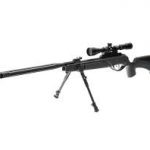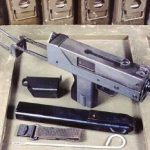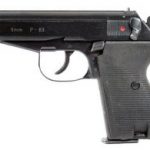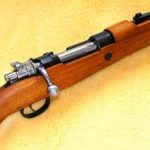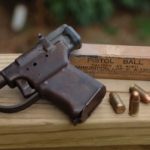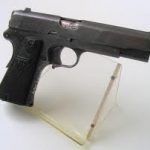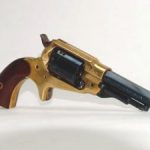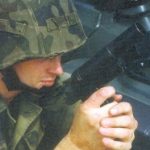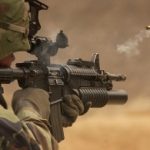UZI
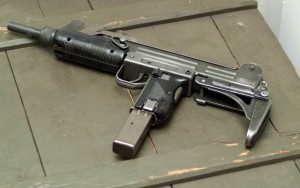
Utarło się przekonanie, że państwo mocne to takie, które posiada własny, dobrze rozwinięty przemysł zbrojeniowy – jest to prawda. W sytuacji wybuchu wojny, jak wielokrotnie już można było doświadczyć tego w historii, sojusze pozostają papierowe, dostawy sprzętu są znikome lub żadne, na ogół na tereny objęte konfliktem zbrojnym nakładane jest często fikcyjne embargo, co eskaluje jeszcze bardziej w stronę kontrabandy uprawianej przez podziemie przestępcze.
Uniezależnienie od dostaw z zewnątrz, dostępność krajowych surowców, oraz jak najbardziej uproszczona budowa konstrukcji broni strzeleckiej (tak by móc ją wytwarzać również w warunkach konspiracyjnych) to walory, z którymi nie można polemizować, chyba dobitnym tego przykładem jest Izrael, który podobnie jak RPA, Polska, Serbia czy Korea Płd. ma niekorzystny układ granic, co sprzyja konfliktom z sąsiadami… Napiszę dziś Państwu o pistolecie czasu wojny – produkcie niemal kultowym, a mianowicie o SMG UZI. W konstrukcji tej da się wyszczególnić bardzo małą ilość części mechanicznych, do wytworzenia których w większości wystarczy tokarka. Układ odprowadzania gazów prochowych, w których pocisk zostaje wystrzelony, a zamek dalej przesuwa się do przodu korzystnie wpływa na jego wagę (zamek uzi waży połowę tego co klasyczny zamek spustowy) Zamek w tej konstrukcji chroni także strzelca w przypadku rozerwania się naboju w komorze. Magazynek wkładany bezpośrednio do rękojeści powoduje instynktowną obsługę nawet w porze nocnej, warunkach zadymienia itp., oraz z pewnością umieszczenie go w rękojeści daje mu lepsze oparcie i bezawaryjność. Magazynki można łączyć ze sobą pod kątem prostym co znakomicie zwiększa szybką ich wymianę i zapewnia dostęp do amunicji w obrębie broni. Magazynki o pojemności 25 i 32 szt. amunicji, zbudowane tak by pociski 9 mm PARA w nich umieszczone układały się pod lekkim kątem przy wprowadzaniu ich do komory nabojowej co sprzyja unikaniu zacięć. Broń posiada dwa bezpieczniki – klasyczny przesuwny w układzie A(AUTOMAT), R(jeden strzał), S(zabezpieczony), umieszczony za spustem po lewej stronie rękojeści, oraz samoczynny chwytowy umiejscowiony w tylnej części rękojeści (dość upierdliwa sprawa) Mechanizm napinania zamka umieszczony na górze, co ma istotne znaczenie dla mańkutów (jak ja),masa broni dość spora, bo załadowana waży 4kg, strzela z zamka otwartego z szybkostrzelnością 600 strz./min. Dostępne wersje standardowe z kolbą metalową, oraz drewnianą, Wersja MINI UZI przeznaczona dla izraelskich oddziałów specjalnych w produkcji od 1982 roku, charakteryzuje się mniejszą w stosunku do wersji standardowej masą (o 1kg), oraz długością (około 15 cm krótsze) i większą szybkostrzelnością (950strz/min). Kolba w tym modelu rozkłada się na prawą stronę broni a nie zaś w dół i do tyłu jak w zwykłym modelu. Istnieją też wersje tej broni strzelające z zamka zamkniętego, wersja MICRO UZI jeszcze bardziej pomniejszona i lżejsza (do 2kg) o szybkostrzelności dochodzącej do 1250 strz./min., produkowana również w kalibrze .45 ACP – wtedy o pojemności 16 nabojów w magazynku, wersja UZI PISTOL – to po prostu micro UZI z opcją na ogień pojedynczy, zaopatrzona w magazynek 20 nabojowy w układzie bezkorbowym, oraz UZI carbine – klasyczne uzi z lufą wydłużoną do 50cm i wersją tylko na ogień pojedynczy. A w praktyce byłem użytkownikiem UZI i Mini UZI przez okres trzech lat – powyższy opis potwierdza zalety i wady tej broni, na pewno jest to pistolet prosty, pewny w działaniu, odporny na trudy służby – nadaje się do działań specjalnych tak samo dobrze jak każdy inny w miarę nowoczesny PM. Ma wady, chociażby takie jak duża waga, bezpiecznik chwytowy (na ogół klei się go taśmą na stałe), latający przed oczami napinacz zamka nie ułatwia celowania, a cena jednostkowa broni jest dość spora.
Mimo to SMG UZI jest moim zdaniem wręcz modelowym przykładem broni czasu wojny.
